The Volkswagen Golf Mk7 is perfect. Pass the wrench. For all those who can't leave well enough alone (which is most of us), here are some suggestions to make your Mk7—GTI or otherwise—ride, rebound, corner, crouch, inform, and steer exactly as you wish.
 | Mk7 Vw Gti Coilover Guide Kw Coilover Kit
| Mk7 Vw Gti Coilover Guide Kw Coilover Kit
KW
For the suspension company that needs no introduction, here's a quick introduction. KW is one of the most respected names in aftermarket suspension, making components for many marques. Its Variant 1, 2, 3, Street Comfort two-way and three-way Clubsport sets fit 1.8T, TDI, and GTI versions of the new Golf. Most of the sets will allow a drop-in ride height down to 1.8 inches at the front and 2.0 inches at the rear. The Street Comfort set is just a little more reserved at 1.4 and 1.6 inches, respectively. From $1,519.99.
kwautomotive.com
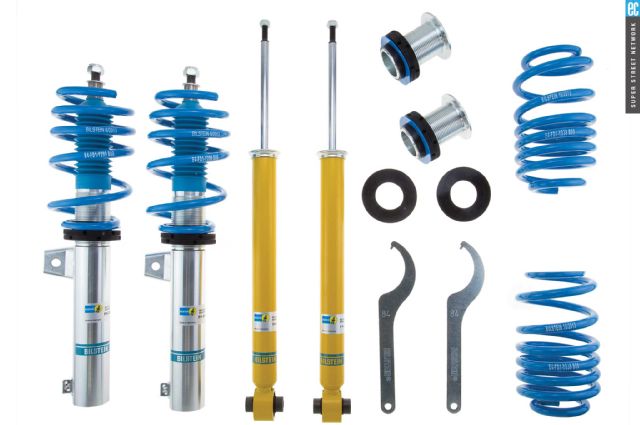 | Mk7 Vw Gti Coilover Guide Bilstein Coilover Kit
| Mk7 Vw Gti Coilover Guide Bilstein Coilover Kit
Bilstein
Bilstein makes original equipment (OE) shock absorbers for Porsche. If that isn't endorsement enough, then the whole world has turned upside down. The company's B6 and B8 kits are standard upgrades, although the B14 is a best seller for the Mk7 Golf, featuring standard monotubes with progressive rate coil springs. Ride height can be lowered from 1.2 inches to 2.0 inches. $1,507.99 (B14).
bilsteinus.com
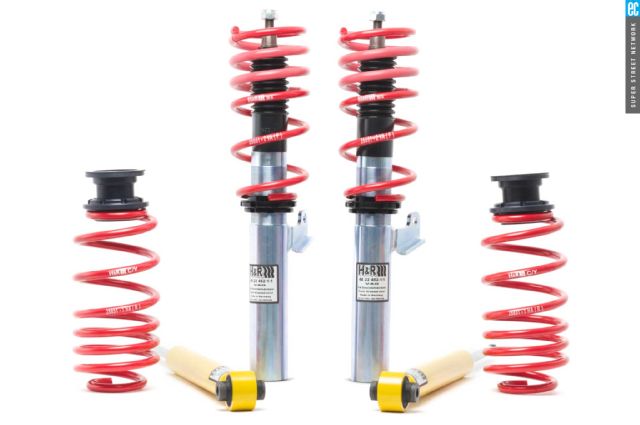 | Mk7 Vw Gti Coilover Guide Hr Coilover Kit
| Mk7 Vw Gti Coilover Guide Hr Coilover Kit
H&R
It's possible to spend larger amounts of money, but H&R's Street Performance coilover set is more in line with some of the alternatives mentioned here. H&R is credited as being the creator of the coilover system, so the company knows a thing or two about spring rates and valving. This system uses a monotube construction and the shock body is fully threaded for adjustability, allowing a drop from 1.0 inch to 2.5 inches. The RSS Clubsport kit adds damping adjustment and more lowering, while the RSS+ kits take it a step further with adjustable camber mounts on the front struts. One hundred percent made in Germany. $1,680.
hrsprings.com
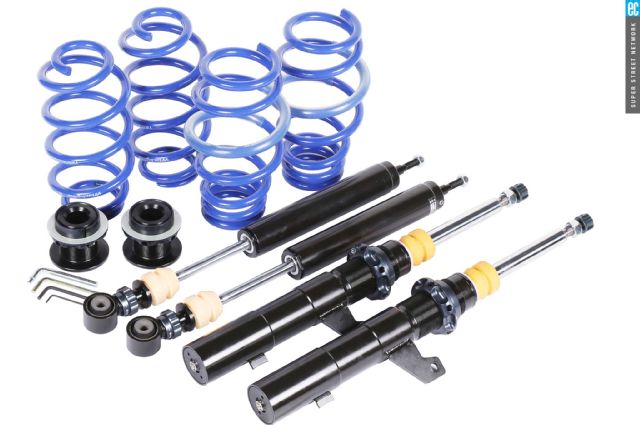 | Mk7 Vw Gti Coilover Guide Volkswagen Racing Coilover Kit
| Mk7 Vw Gti Coilover Guide Volkswagen Racing Coilover Kit
Volkswagen Racing
This is a British company but with a North American distributor. VWR has a lot of experience in rallying, which (as we all know) is one of the most exciting forms of motorsport ever—and why isn't it on TV more? Sorry, slight digression. Anyway, a lot of that expertise has gone into this StreetSport Plus kit. It's 12-way adjustable without needing tools or jacking, and the company claims the adjusters are "beautifully over-engineered." Ride height range for the GTI is 2.4 inches at the front, 2.8 inches at the rear. Upgraded springs and top-mount camber plates are also available. $2,199.
racingline-usa.com
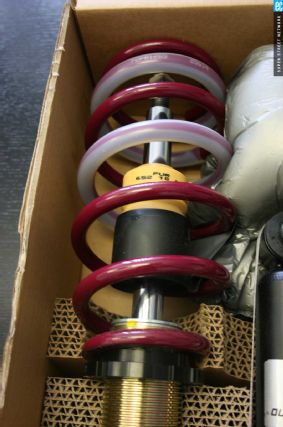 | Mk7 Vw Gti Coilover Guide Vogtland Coilover
| Mk7 Vw Gti Coilover Guide Vogtland Coilover
Vogtland
The usual suspects like KW and Bilstein become the usual suspects because they're so good. But that doesn't mean they're the only worthwhile options out there. Vogtland's adjustable twin-tube shocks can drop ride height by up to 3 inches, shine on the track, and still be eminently usable on the street. $919.99.
vogtland-na.com
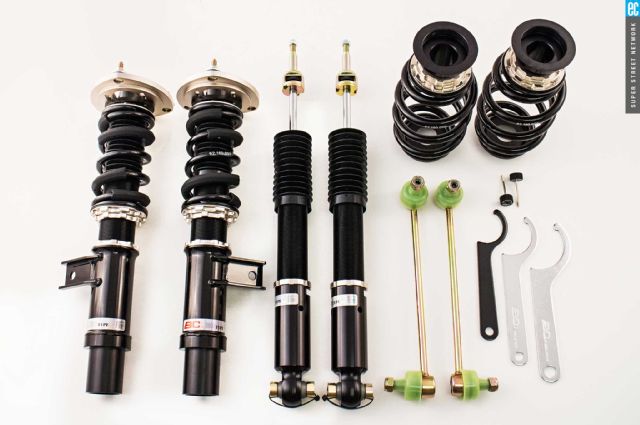 | Mk7 Vw Gti Coilover Guide Bc Racing Coilover Kit
| Mk7 Vw Gti Coilover Guide Bc Racing Coilover Kit
BC Racing
These Type BR monotube shocks for the GTI are primarily for the street, but can also perform occasional track duties. Which, let's face it, are what most of us are looking for. They come with pillowball mounts, and the adjustment knobs are easy to access for fine tuning, offering 30 levels of compression and rebound. Height is adjusted via the shock body, not the spring. BC also does custom spring rates and an extreme low option. $999.98.
bcracing-na.com
Analyzing the Coilover
By Aaron Bonk
 | Hr Street Performance Coilovers
| Hr Street Performance Coilovers
Nobody ever said making your car handle better would be easy. Camber, caster, toe, roll centers, and motion ratios all make the fine art of suspension tuning quite the opposite. If it weren't for your tires, your car's springs and dampers would be the number one thing that would determine how well it'd handle. Knowing that, deciding on the correct coilovers could be the most important decision you make on your project car, no matter what kind of car you start with.
You really have two basic choices when it comes to replacing whatever springs and dampers the original manufacturer of your car subjected you to: stiffer, higher-performance springs and dampers that are differently tuned versions of what you already have. Second, are threaded-body coilovers that allow a greater range of adjustment and are generally sold as a single package. Knowing which of the two options you're willing to pay for is the easy part. You've also got to think about all sorts of important choices, like spring rates, what all of this is made out of, whether or not damping is adjustable, and if you should splurge for monotube dampers in lieu of more economical twin-tube varieties.
 | Hr Cupkit
| Hr Cupkit
Coilover Vs. Coilover
Threaded-body coilovers have officially hijacked the use of the word "coilover." As it turns out, just about any shock or strut with a coil spring wrapped around it is technically worthy of the coilover title, whether we're talking about something you'll find underneath a mid-'90s Peugeot or an E46 M3. The similarities end with the name, though. Only threaded-body coilovers replace the entire factory spring-and-damper assembly and feature threaded shock bodies for easy ride-height adjustments, and, in many cases, adjustable damping. As a quick side note, there is some confusion when it comes to springs with adjustable perches where the spring is not over the shock, i.e. the rear suspension of most Volkswagens since 1998. For whatever reason, the industry still refers to them as coilovers, simply to express the adjustability. On aftermarket systems bearing the coilover name, ride-height changes are made possible through a series of jam nuts that compress or decompress the springs, or by means of threaded lower bodies that can be screwed in or out, altering a damper's length.
 | Camber Adjustable Top Mounts
| Camber Adjustable Top Mounts
Spend your money wisely and you'll end up with threaded-body coilovers that also include whatever bumpstops, dust boots, and upper mounts your car needs. All of this can vary depending on the application, like with a coilover's upper mount, for example, that'll differ between MacPherson-strut-based and double-wishbone-shock-based applications. Coilovers designed for struts typically feature pillow-ball mounts and the higher-end units sometimes incorporate camber and caster adjustability. Shock-based coilovers generally feature fixed-upper mounts since the alignment adjustments don't take place at the shock.
The Damper
Every coilover is based around a shock body, or a damper. As with any damper, the coilover's upper half mounts to the car and its lower to either an A-arm or a knuckle, depending on whether we're talking about a double-wishbone, multi-link or MacPherson-strut suspension.
It's the dampers that help prevent spring oscillations and vibrations caused by the wheels and chassis. Hit a bump and the damper allows the spring to compress and decompress, and if it does what it's designed to do, it'll eliminate any additional oscillations. The energy, or shock, from hitting a bump or g-force generated body movement is stored briefly and then rereleased by the spring is "absorbed" by the damper. All you care about is that the bump's now pretty much unnoticeable. How well all of this works, of course, depends on what's inside that damper. For example, internals that are tuned to be too stiff can slow down all of this spring movement while insides that are tuned too soft will do the opposite. Dampers do a whole lot more than just regulate spring movement. They also reduce or eliminate rocking, pitching, dipping and pretty much everything else you'd imagine that isn't supposed to happen when going around a corner, accelerating, or stabbing the brake pedal.
Look inside a coilover's shock body and you'll find a fluid-filled tube and a piston. Here, the piston pushes high-pressure hydraulic fluid through the damper's valving, which controls how all of this will respond when counteracting spring movement. Kinetic energy pent up through suspension movement turns into heat energy that, when all goes well, dissipates within the damper's fluid. And that valving, well, it's determined by all sorts of little orifices perforated into the damper's piston that let's hydraulic fluid seep through in specific quantities as it moves up and down. Do all of this right and you're on your way to something that would appear to be black magic, if you didn't have a basic understanding of fluid mechanics.
One Tube or Two
Threaded-body coilovers, for the sake of this discussion, are made up of one of two kinds of dampers: mono-tube or twin-tube. Mono-tube dampers control compression and rebound from within a single cylinder, or tube; it encapsulates a piston-and-shaft assembly. Twin-tube dampers are made up of two cylinders—an inner one that houses the same sort of piston and shaft, and a second one that surrounds all of this and stores the damper's hydraulic fluid.
Twin-tube proponents will point out their increased piston strokes, which can affect ride quality and handling in very good ways, and is typically more than anybody needs for most street applications. Monotube dampers, on the other hand, are made up of larger-diameter internals that can displace more fluid, which means they're a whole lot more sensitive to suspension movement and respond accordingly. That additional fluid flow also means more consistent damping and cooler operating temperatures. Mono-tube dampers are typically more expensive, though, which is mostly attributed to a more complex design.
Shock Travel
Bottoming out will never be a good thing, which means shock travel should be a concern to you. Bottom out onto your bumpstops because your car's too low and you've just defeated about every suspension mod you've done to your car thus far. More travel is better and allows a damper to do its job as designed. Look to a coilover's springs to determine just how much travel there should be; stiffer springs don't need as much shock travel since they won't compress as much, while softer ones mean the opposite. Despite most of the misinformation out there, the lowest and stiffest you can get your car, usually isn't the best for handling.
Compression and Rebound
Every threaded-body coilover worth its weight in aluminum or steel can be damped in one of two ways: through pre-set valving calibrated by the manufacturer, which just so happens to be matched with whatever springs they're paired with, or by means of single- or double-adjustable controls (typically knobs) that users can dial in to whatever they prefer, for better or worse.
But first you've got to understand what the heck is being adjusted. We're talking about compression and rebound, which really, after all, is what you're trying to improve by slapping coilovers on in the first place. Compression happens when the damper's piston moves down into its body, attempting to squish all of that unsquishable hydraulic fluid. Rebound occurs when the piston's moved away, still compressing that hydraulic fluid but in the other direction. Generally speaking, compression controls the motion of the car's unsprung weight while rebound controls the motion of its sprung weight. In other words, compression controls how fast weight is applied toward the tire while rebound controls how fast weight moves away.
Single-adjustable coilovers allow for compression and rebound adjustments that are dependent upon one another. Stiffen one and you've just done the same to the other by means of a single turn of the knob. That said, damping changes among these sorts of coilovers typically only affect low-speed rebound as opposed to any sort of dramatic compression changes. Double-adjustable—also known as split-level—coilovers allow for compression and rebound changes independent of one another. Depending on the coilover, adjustments can vary from as few as 5 to 32 or more positions. In most cases, such single- or double-adjustable coilovers feature externally mounted knobs that control preload against a spring-loaded needle valve, which determines how much fluid will flow internally. These sort of damping adjustments have their role to play, but don't mistake a few clicks of a coilover for playing as vital a role among your suspension as your tires, spring rates, or anti-roll bars do. In other words, dial-in the rest of your suspension first before looking to this sort of fine-tuning.
We'd be remiss if we didn't mention shaft speed, or the rate at which a damper's valve does its job. Slower shaft speeds typically influence handling while higher shaft speeds determine how well a damper will do its job when going over bumps. A well-designed damper can perform at all sorts of different speeds, resulting in the sort of performance you care about and the sort of compliance your grandmother needs.
 | Hr Springs
| Hr Springs
The Spring
It isn't the dampers that store the energy from bumps and body roll; that's what springs are for. They do all of this by compressing and decompressing to effect wheel motion. Springs keep the chassis from bottoming out, maintain tire position when going over bumps, and ward off body roll when turning. Springs also reduce squat when stepping on the gas and diving when applying the brakes. More obviously, they establish a car's ride height, which determines its center of gravity. Spring rates should be considered carefully. Err on the soft side and bottoming out could be in your future. Stiffen things up too much and your tires will never maintain complete contact with the pavement.
You can't talk about coilovers and springs without mentioning preload, which is really just the amount of pressure applied to a spring once installed. Increased preload can help with mechanical grip by allowing more of a tire's contact patch to be utilized more of the time, but too much can do the opposite. Any coilover that relies on adjusting spring preload in order to adjust ride height ought to be considered carefully if you plan on visiting the track on a regular basis.
Coilovers might seem simple enough, but stick on the wrong ones and you'll likely make your car handle worse than before. Be sure to consider a potential coilover's design, materials, wear, reliability, and rebuilding potential as well as its intended use. No matter how much adjustability whatever coilover you're thinking about offers, if they weren't designed properly to begin with, no amount of knob turning or spring compressing will help. As it turns out, a shoddy set of coilovers can bring out the worst in an otherwise good suspension, so unless you're already an expert in suspension dynamics, you're best off siding with a reputable brand and trust somebody there does know a thing or two about helping you make the right choices.
 | Hrsprings Rs Coilovers
| Hrsprings Rs Coilovers

